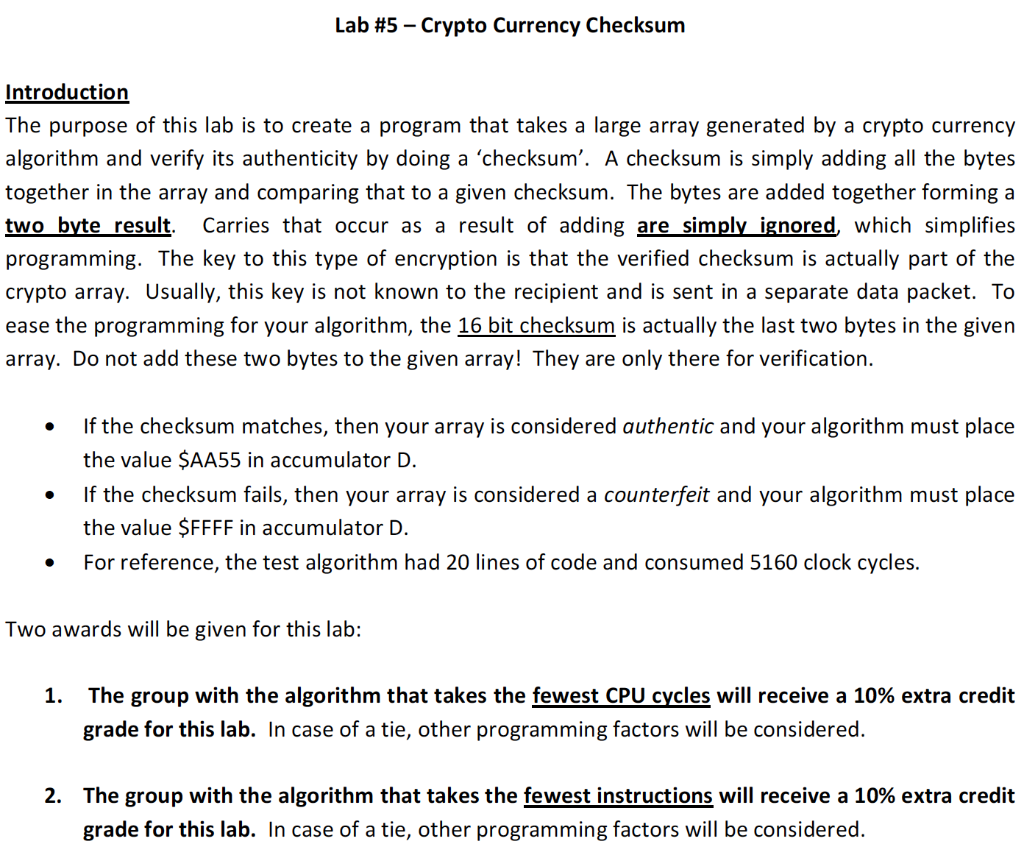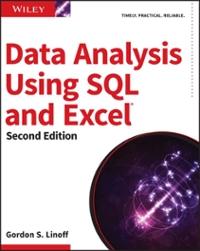Question
I need a program flowchart for the following instruction: Introduction The purpose of this lab is to create a program that takes a large array
 I need a program flowchart for the following instruction:
I need a program flowchart for the following instruction:
Introduction The purpose of this lab is to create a program that takes a large array generated by a crypto currency algorithm and verify its authenticity by doing a checksum. A checksum is simply adding all the bytes together in the array and comparing that to a given checksum. The bytes are added together forming a two byte result. Carries that occur as a result of adding are simply ignored, which simplifies programming. The key to this type of encryption is that the verified checksum is actually part of the crypto array. Usually, this key is not known to the recipient and is sent in a separate data packet. To ease the programming for your algorithm, the 16 bit checksum is actually the last two bytes in the given array. Do not add these two bytes to the given array! They are only there for verification. If the checksum matches, then your array is considered authentic and your algorithm must place the value $AA55 in accumulator D. If the checksum fails, then your array is considered a counterfeit and your algorithm must place the value $FFFF in accumulator D. For reference, the test algorithm had 20 lines of code and consumed 5160 clock cycles.
Lab #5-Crypto Currency Checksum Introduction The purpose of this lab is to create a program that takes a large array generated by a crypto currency algorithm and verify its authenticity by doing a 'checksum'. A checksum is simply adding all the bytes together in the array and comparing that to a given checksum. The bytes are added together forming a two byte result. Carries that occur as a result of adding are simply ignored which simplifies programming. The key to this type of encryption is that the verified checksum is actually part of the crypto array. Usually, this key is not known to the recipient and is sent in a separate data packet. To ease the programming for your algorithm, the 16 bit checksum is actually the last two bytes in the given array. Do not add these two bytes to the given array! They are only there for verification. If the checksum matches, then your array is considered authentic and your algorithm must place the value SAA55 in accumulator D. .If the checksum fails, then your array is considered a counterfeit and your algorithm must place the value $FFFF in accumulator D. For reference, the test algorithm had 20 lines of code and consumed 5160 clock cycles. Two awards will be given for this lab: The group with the algorithm that takes the fewest CPU cycles will receive a 10% extra credit grade for this lab. In case of a tie, other programming factors will be considered 1. The group with the algorithm that takes the fewest instructions will receive a 10% extra credit grade for this lab. In case of a tie, other programming factors will be considered 2. Lab #5-Crypto Currency Checksum Introduction The purpose of this lab is to create a program that takes a large array generated by a crypto currency algorithm and verify its authenticity by doing a 'checksum'. A checksum is simply adding all the bytes together in the array and comparing that to a given checksum. The bytes are added together forming a two byte result. Carries that occur as a result of adding are simply ignored which simplifies programming. The key to this type of encryption is that the verified checksum is actually part of the crypto array. Usually, this key is not known to the recipient and is sent in a separate data packet. To ease the programming for your algorithm, the 16 bit checksum is actually the last two bytes in the given array. Do not add these two bytes to the given array! They are only there for verification. If the checksum matches, then your array is considered authentic and your algorithm must place the value SAA55 in accumulator D. .If the checksum fails, then your array is considered a counterfeit and your algorithm must place the value $FFFF in accumulator D. For reference, the test algorithm had 20 lines of code and consumed 5160 clock cycles. Two awards will be given for this lab: The group with the algorithm that takes the fewest CPU cycles will receive a 10% extra credit grade for this lab. In case of a tie, other programming factors will be considered 1. The group with the algorithm that takes the fewest instructions will receive a 10% extra credit grade for this lab. In case of a tie, other programming factors will be considered 2Step by Step Solution
There are 3 Steps involved in it
Step: 1

Get Instant Access to Expert-Tailored Solutions
See step-by-step solutions with expert insights and AI powered tools for academic success
Step: 2

Step: 3

Ace Your Homework with AI
Get the answers you need in no time with our AI-driven, step-by-step assistance
Get Started


